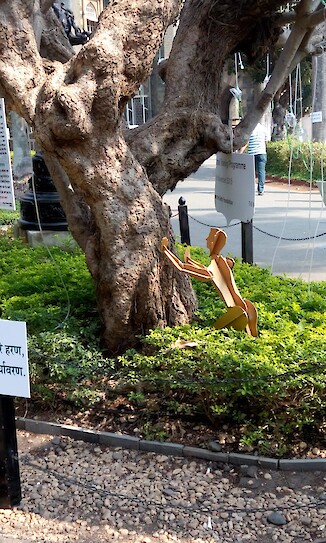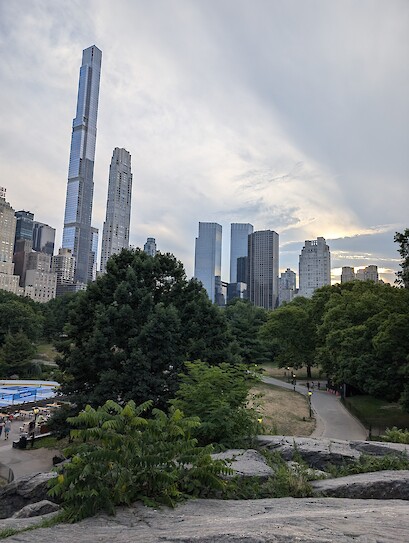Hot cities, Cool solutions: Exploring the Urban Heat Island Effect
Ronita Sequeira ·Extreme heat is now the leading cause of weather-related deaths in the United States. As temperatures rise and climate change intensifies, cities are particularly vulnerable due to the Urban Heat Island (UHI) effect, where metropolitan areas are significantly hotter than surrounding rural regions. Understanding this phenomenon is important for public health, urban planning, and building climate resilience as more and more people are moving into the cities.
The UHI effect is driven by:
- Heat-absorbing materials like asphalt and concrete.
- Tall buildings that trap heat and restrict airflow.
- Lack of vegetation, which typically provides cooling through shade and evaporation.
Dr. T. R. Oke's research on UHI highlights that larger cities experience a more pronounced effect due to their size and density. The heat that builds up in cities, particularly at night, forms a "heat bubble," which poses serious health risks to urban populations.
Health Risks of the UHI Effect
Dr. Clifford Mitchell, Director at the Maryland Department of Health, has warned about the increased risk of heat-related illnesses like heatstroke and exhaustion, which can be fatal if not treated. He notes that populations most at-risk—children, the elderly, and those with pre-existing conditions—face compounded threats from rising urban temperatures. In addition, hot urban areas often suffer from poor air quality, which exacerbates respiratory issues, especially among vulnerable populations.
Heatwaves are predicted to become more frequent and intense with climate change, making cities, already affected by UHI, even more dangerous. Dr. Mitchell has highlighted the importance of public health preparedness, especially in addressing heat-related bacterial illnesses.
Dr. Scott Curtis, from The Citadel, conducted a study using wet bulb globe temperature devices and thermal imaging with the help of the students and the local community and concluded that certain urban surfaces, like pavements, should be treated with special coatings. These coatings can reduce pollution, rejuvenate materials, and extend the life of pavements while mitigating heat absorption.

The tree, a symbol of nature is being "saved" by a paper cutout of a human, suggesting fragility and vulnerability. The paper cutout could represent human efforts to protect nature, perhaps showing that these efforts, while significant, are delicate and need more strength or commitment. The image suggests a sense of responsibility, underscoring that humans must act to preserve nature, but it also hints at the complexity and challenge of doing so effectively. Source: Photo by Ronita Sequeira.

Cooling Strategies
While the UHI effect presents challenges, some strategies can help cool cities:
- Green spaces: Parks and urban forests can cool cities by providing shade and promoting evaporation.
- Reflective materials: Using heat-reflective construction materials for pavements and roofs reduces heat absorption.
- Better building design: Improved cooling, ventilation, and insulation systems can protect urban populations from heat stress.
- Tree planting: Urban trees improve air quality and reduce temperatures by offering shade and facilitating evapotranspiration.

Tall buildings in New York City use heat-reflective construction materials to reduce heat and the neighborhood is surrounded by green spaces to keep the areas cool. Source: Photo by Ronita Sequeira.
By incorporating these strategies into sustainable urban planning, cities can become more resilient to rising temperatures. Urbanization may lead to the UHI effect, but with smart interventions, we can mitigate its worst impacts. The key to success lies in collaboration between public health experts like Dr. Mitchell and climate scientists such as Dr. Curtis, working alongside urban planners to create heat-resilient communities.
Future generations can enjoy safer and healthier urban environments if we recognize and address the UHI effect today.
Sources:
- Heaviside, C., Macintyre, H., & Vardoulakis, S. (2017). The urban heat island: Implications for health in a changing environment. Current Environmental Health Reports, 4(3), 296-305. https://doi.org/10.1007/s40572-017-0140-1
- McGregor, G. R., & Vanos, J. K. (2018). Heat: A primer for public health researchers. Public Health, 161, 138-146. https://doi.org/10.1016/j.puhe.2018.08.002
- Oke, T. R. (1973). City size and the urban heat island. Atmospheric Environment, 7(8), 769-779. https://doi.org/10.1016/0004-6981(73)90140-6
About the author
Ronita Sequeira

I am a second-year master's student in the MEES Program at UMBC. My research focuses on measuring the abundance, diet, and condition of fish near restored wetlands. I have an indoor plant collection, which I enjoy working on. I also like doing nail art and crocheting in my free time.
Next Post > Make Some Noise with Data & Sound Science
Comments
-
Alison Novara 1 year ago
Great blog, Ronita! I really enjoyed the use of your own photos and how you interpreted them in your post. They were very timely and related quite well, and they were also really cool! I liked the paper human holding up the tree the best. Also, I feel you highlighted all of the major, pertinent issues with UHIs and how it affects human populations in an easily readable format. Tying in Dr. Mitchell and Dr. Curtis' research was also fascinating and helped your post flow so well. Ending it on a positive note helped to make it a great read!
-
Ian Kalama 1 year ago
Love this! This blog provides a comprehensive look at the Urban Heat Island (UHI) effect, highlighting how urban environments are increasingly vulnerable to extreme heat due to materials like asphalt, building design, and lack of greenery. The health risks, particularly for vulnerable populations, are significant, and the solutions offered—including green spaces, reflective materials, and better urban design—are essential for building climate resilience through collaboration between urban planners, public health experts, and climate scientists is well depicted in this blog and the photographs in this blog beautifully illustrate both the challenges and solutions associated with the Urban Heat Island effect. The image of the paper human holding up the tree is especially striking, symbolizing humanity's delicate yet vital efforts to protect nature. The photos showcasing green spaces, heat-reflective materials, and thoughtful urban design effectively convey practical measures to combat urban heat, making the concepts more relatable and visually impactful. These visuals not only complement the text but also deepen our understanding of how cities can adapt to rising temperatures through innovative planning and community efforts.
-
Joan Huai 1 year ago
Hi Ronita! This is a nicely written post that is digestible even for those who might not be in the field, thank you for your diligent work on this. I also appreciate you underscoring the grave impacts of climate change/emergency particularly on urban settings like Baltimore while also providing potential solutions to remedy it.
-
Jun Suk Byun 1 year ago
Very informative! I felt it flowed smoothly and was easy to read. I like how you used the pictures to complement the content and summarized the information in bullet points. I enjoyed reading it!
-
Taylor Breton 1 year ago
Nice work! I really liked the flow of this blog! I also agree that the use of photos that you took yourself really helped tie in the whole blog. I really liked your interpretation of the picture of the paper human cut out holding the tree, that was a great perspective to add in.
-
Adetutu Adebayo 1 year ago
The effect of urban heat is devastating, both on humans' health and the environment, the effects encompass everything in general. Efforts should be made to reduce the heat waves by implementing the cooling strategies such as: green spaces, reflective materials, better building design, tree planting and lots more.
-
Anikka 1 year ago
Ronita, great synthesis of UHI effects and remedies! This blog is well thought out and contributes to the developing awareness of what can be done to address urban heat islands. Urban planning has a long road ahead of itself in tackling these types of infrastructure related environmental issues.
-
Loni Matthew 1 year ago
Great blog! The effects of urban heat will only seem to intensify with time. It's also nice how you added your own photography to it.

